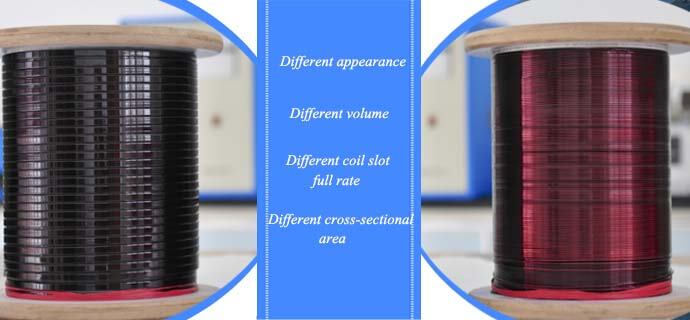- Email: sales@flait-aluminum.com
- Tel: 0086-13203837398
Enameled wire is the main raw material for products such as motors, electrical appliances and household appliances. It can be divided into round wire and rectangular/flat wire according to different shapes.
 1. Different appearance
1. Different appearanceThe shape of enameled rectangular wire is flat, and the shape of enameled round wire is round.
 2. Different volume
2. Different volumeDue to the different shapes, the volumes of the two enameled wires are also different. The coil of enameled rectangular wire occupies less space than that of enameled round wire, which can save 9-12% of space.
 3. Different coil slot full rate
3. Different coil slot full rate
The slot full rate refers to the proportion of the space occupied by the coil in the slot after it is placed in the slot. The definition is generally the ratio of the cross-sectional area of the wire to the effective area of the slot. Under the same winding space conditions, the slot full rate of enameled copper rectangular/flat wire can reach more than 95%, while the slot full rate of enameled round wire is only 78%.
 4. Different cross-sectional area
4. Different cross-sectional areaCompared with enameled copper round wire, enameled copper rectangular wire has a larger cross-sectional area, and its heat dissipation area is also increased accordingly, and the heat dissipation effect is better.
Compared with enameled round wire and enameled rectangular wire, enameled rectangular wire is better. It has three main advantages:
 1. Higher power density
1. Higher power densityEnameled rectangular wire has a higher slot fill rate, which helps to improve power density. Differentiating flat wire is conducive to improving the slot fill rate of motors. At the same power level, the slot fill rate of enameled flat wire is 20%-30% higher than that of enameled round wire. The increase in slot fill rate means that more copper wire can be filled under the premise of unchanged space, generating stronger magnetic field strength and improving power density.
 2. Lower cost
2. Lower costEnameled flat wire can reduce copper loss and help reduce costs. Enameled flat wire has a larger surface area than enameled round wire, which greatly improves the skin effect, reduces the loss of high-frequency current, has good heat dissipation performance, and is suitable for high-frequency conduction environments. The resistance of the motor winding is inversely proportional to the cross-sectional area of the wire: R=ρl/S (ρ is the winding resistivity, l is the wire length, and S is the cross-sectional area of the conductor). Under the condition of constant resistivity and length, the increase of 20~30% copper filling amount brought by flat wire can significantly increase the cross-sectional area of the motor conductor, thereby reducing the resistance of the motor winding. Therefore, the copper loss of the motor winding can be effectively reduced.
 3. Better thermal conductivity
3. Better thermal conductivityThe contact area between enameled flat wires is large, and compared with enameled round wires, the thermal conductivity is better and the temperature rise is lower. In the same winding space, the enameled flat wire can have a larger cross-sectional area than the enameled round wire, so that the coil slot full rate is high, the resistance is reduced, and a larger current is obtained to avoid overheating of electronic products.
The materials of enameled aluminum wire and enameled copper wire are different. When changing, pay attention to the conversion size. The specific conversion formula is:
D copper = (ρ copper / ρ aluminum) / 2 * D aluminum
D copper: copper wire diameter; D aluminum: aluminum wire diameter; ρ aluminum: aluminum resistivity, take 1/35.5; ρ copper: copper resistivity, take 1/58.
For example, when using 1.18mm aluminum enameled wire and changing to copper wire, the wire diameter of the copper wire is D copper = (35.5/58) 1/2 * 1.18 = 0.61211/2 * 1.18 = 0.7823 * 1.18 = 0.92, that is, after 1.18mm aluminum enameled wire is changed to copper enameled wire, it needs to be replaced by 0.92mm copper wire.
Original Source:Magnet Wires for Power Industry